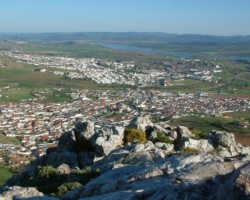Wealth arising from mining and industry allowed Peñarroya-Pueblonuevo to escape its condition as a hamlet. Having past Belmez, which appears to sleep at the foot of its castle, a few kilometres further on, visitors come to Pueblonuevo and Peñarroya, respectively, which, as a result of wealth arising from mining and industry, escaped their condition as hamlets and were amalgamated into a prosperous town and the economic capital of the region. The profile of a magnificent rocky outcrop dominates the horizon next to the town, like a watchful and protective sentinel.
- The village is located in the Alto Guadiato [Upper Guadiato], next to the N-432.
- Distance from Córdoba: 79 km.
- Altitude: 577 m.
- Surface area: 63.1 km2.
- Population: 12.050.
- Term used to designate inhabitants: Peñarroyenses.
- Region: Valle del Guadiato.
Peñarroya-Pueblonuevo is the result of the union of two villages. The former is the oldest, taking its name from the nearby rocky outcrop [Peña], and was first mentioned in the 13th century. When the livestock dealer José Simón de Lillo discovered coal fields in 1778, the future of this hamlet, which was a dependency of Bélmez, changed forever. This change was particularly evident during the 19th century, following the installation of important industrial and mining companies in the area, most notably the French Mining and Metallurgical Company of Peñarroya. This mining and industrial development also gave rise to the creation of Pueblonuevo and El Terrible in the second half of the 19th century, which soon merged into a single settlement. The resulting hamlet was a dependency of Bélmez up until 1894, when it achieved independence, and two years later Peñarroya followed the same path. The two municipalities were finally merged in 1927.












